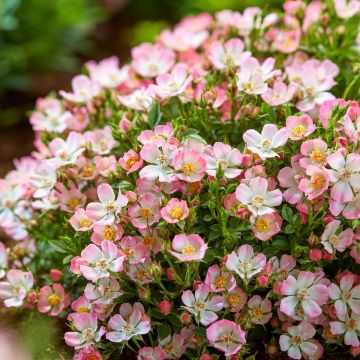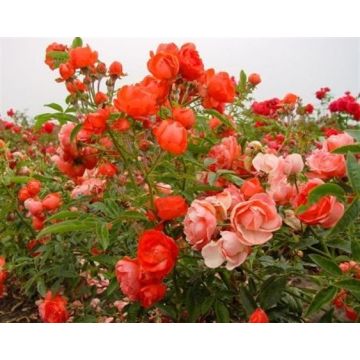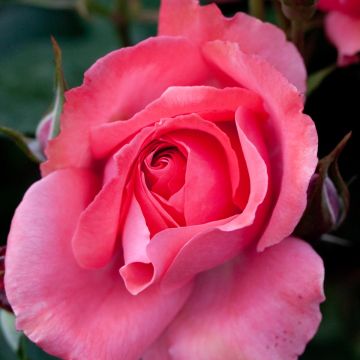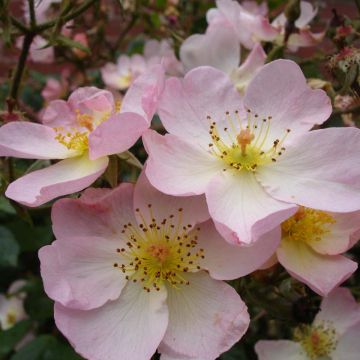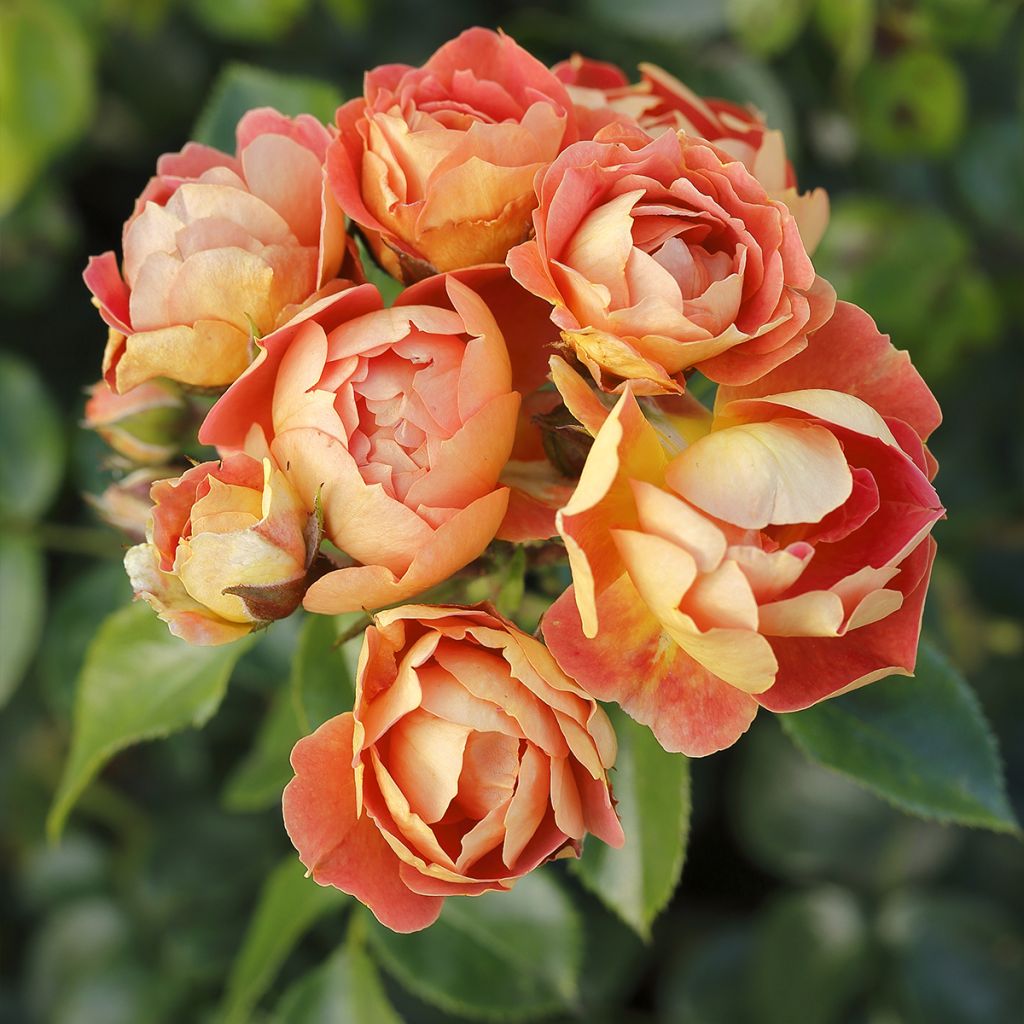

Rosier à fleurs groupées Bienenweide Mango
Rosa Bees Paradise Mango - Patio Rose
Rosa x polyantha Bees Paradise® Mango (Bienenweide)
polyantha rose
This plant carries a 24 months recovery warranty
More information
We guarantee the quality of our plants for a full growing cycle, and will replace at our expense any plant that fails to recover under normal climatic and planting conditions.
From €5.90 for pickup delivery and €6.90 for home delivery
Express home delivery from €8.90.
Delivery to Corse prohibited: UE law prohibits the import of this plant from mainland France to Corse as part of the fight against Xylella fastidiosa. Please accept our sincere apologies.
More information
Does this plant fit my garden?
Set up your Plantfit profile →
Description
Rosa Bees Paradise Mango, with its small globular flowers, adds something new to this collection of small roses developed by the German rose breeder Tantau to attract and nourish bees. Its lovely romantic roses open late and offer a particularly attractive mix of colours. Floriferous and easy to grow, all these roses have a large, easily accessible heart of pollen-rich stamens. Bees Paradise roses are small and flower all summer, so fit into gardens of all sizes and styles. They are also perfect for container gardening.
The flowers of Bees Paradise Mango gathered in small terminal clusters, come from the polyantha rose, an old hybrid derived from Rosa multiflora and R. chinensis. They are particularly rich in nectar and pollen. It forms a well-branched, low bush, about 50 cm (20in) high and 60 cm (24in) wide. The semi-double, 2 to 4 cm (1 to 2in) in diameter flowers, are composed of 5 to 10 shell-shaped petals, opening very slowly in a cup shape. They open late to reveal a golden yellow stamen-filled heart. The outer petals are initially yellow and fade to a slight blush. The interior changes from coral orange to orange pink. Flowering begins in June and repeats in successive waves until October. In Bees Paradise roses, the faded flowers fall off on their own, without the need for pruning. Flowering slows down if the soil is too dry in summer and picks up again in September. This variety develops dark green, smooth, deciduous foliage that falls in autumn. Its resistance to rose diseases is good.
Bees Paradise Mango is robust and hardy andwill thrive in all soils that are not too dry, but prefers fertile and deep soils. Its dense and low habit allows it to be used in large borders, not too dry rockeries or on a slope. It can also be planted in groups of 5 in the centre of a small flowerbed. Plant it en masse along a pathway or to highlight shrub borders. It pairs well with light or opulent perennials, or with other dwarf roses from the 'Bienenweide' and Bees Paradise series, 'Bordure Blanche' rose, or 'Bordure vive' rose. It can be planted with perennial geraniums (Geranium Blue Cloud, Anne Folkard, Nimbus, Orion, Rozanne), campanulas (lactiflora, rapunculoides), catmints, snapdragons, foxgloves, or carnations. It is perfect for decorating the terrace or balcony, planted in a beautiful pot or a planter.
Obtained by Tantau (Germany) in 2021.
Report an error about the product description
Plant habit
Flowering
Foliage
Botanical data
Rosa
x polyantha
Bees Paradise® Mango (Bienenweide)
Rosaceae
polyantha rose
Cultivar or hybrid
Other Dwarf and mini Roses
Planting and care
Bees Paradise rose bushes prefer a sunny location (at least 4 to 5 hours of sunshine per day) but sheltered from the scorching midday sun and strong winds. They like loose, permeable, deep, and fertile soils. They prefer neutral to slightly acidic soil but will thrive in any garden as long as the soil is well-cultivated and sufficiently rich. To plant your rose, work the soil to a depth of 25 cm (10in) and put a base fertiliser in the planting hole such as bonemeal. Remove your rose from its pot and position by covering the top of the root ball with 3 cm (1in) of soil, fill and water generously to eliminate air pockets. In dry weather, regular watering is necessary for a few weeks to aid root growth. Provide your rose with special rose fertiliser that stimulates flowering.
Planting period
Intended location
Care
This item has not been reviewed yet - be the first to leave a review about it.
Roses by purpose
Haven't found what you were looking for?
Hardiness is the lowest winter temperature a plant can endure without suffering serious damage or even dying. However, hardiness is affected by location (a sheltered area, such as a patio), protection (winter cover) and soil type (hardiness is improved by well-drained soil).

Photo Sharing Terms & Conditions
In order to encourage gardeners to interact and share their experiences, Promesse de fleurs offers various media enabling content to be uploaded onto its Site - in particular via the ‘Photo sharing’ module.
The User agrees to refrain from:
- Posting any content that is illegal, prejudicial, insulting, racist, inciteful to hatred, revisionist, contrary to public decency, that infringes on privacy or on the privacy rights of third parties, in particular the publicity rights of persons and goods, intellectual property rights, or the right to privacy.
- Submitting content on behalf of a third party;
- Impersonate the identity of a third party and/or publish any personal information about a third party;
In general, the User undertakes to refrain from any unethical behaviour.
All Content (in particular text, comments, files, images, photos, videos, creative works, etc.), which may be subject to property or intellectual property rights, image or other private rights, shall remain the property of the User, subject to the limited rights granted by the terms of the licence granted by Promesse de fleurs as stated below. Users are at liberty to publish or not to publish such Content on the Site, notably via the ‘Photo Sharing’ facility, and accept that this Content shall be made public and freely accessible, notably on the Internet.
Users further acknowledge, undertake to have ,and guarantee that they hold all necessary rights and permissions to publish such material on the Site, in particular with regard to the legislation in force pertaining to any privacy, property, intellectual property, image, or contractual rights, or rights of any other nature. By publishing such Content on the Site, Users acknowledge accepting full liability as publishers of the Content within the meaning of the law, and grant Promesse de fleurs, free of charge, an inclusive, worldwide licence for the said Content for the entire duration of its publication, including all reproduction, representation, up/downloading, displaying, performing, transmission, and storage rights.
Users also grant permission for their name to be linked to the Content and accept that this link may not always be made available.
By engaging in posting material, Users consent to their Content becoming automatically accessible on the Internet, in particular on other sites and/or blogs and/or web pages of the Promesse de fleurs site, including in particular social pages and the Promesse de fleurs catalogue.
Users may secure the removal of entrusted content free of charge by issuing a simple request via our contact form.
The flowering period indicated on our website applies to countries and regions located in USDA zone 8 (France, the United Kingdom, Ireland, the Netherlands, etc.)
It will vary according to where you live:
- In zones 9 to 10 (Italy, Spain, Greece, etc.), flowering will occur about 2 to 4 weeks earlier.
- In zones 6 to 7 (Germany, Poland, Slovenia, and lower mountainous regions), flowering will be delayed by 2 to 3 weeks.
- In zone 5 (Central Europe, Scandinavia), blooming will be delayed by 3 to 5 weeks.
In temperate climates, pruning of spring-flowering shrubs (forsythia, spireas, etc.) should be done just after flowering.
Pruning of summer-flowering shrubs (Indian Lilac, Perovskia, etc.) can be done in winter or spring.
In cold regions as well as with frost-sensitive plants, avoid pruning too early when severe frosts may still occur.
The planting period indicated on our website applies to countries and regions located in USDA zone 8 (France, United Kingdom, Ireland, Netherlands).
It will vary according to where you live:
- In Mediterranean zones (Marseille, Madrid, Milan, etc.), autumn and winter are the best planting periods.
- In continental zones (Strasbourg, Munich, Vienna, etc.), delay planting by 2 to 3 weeks in spring and bring it forward by 2 to 4 weeks in autumn.
- In mountainous regions (the Alps, Pyrenees, Carpathians, etc.), it is best to plant in late spring (May-June) or late summer (August-September).
The harvesting period indicated on our website applies to countries and regions in USDA zone 8 (France, England, Ireland, the Netherlands).
In colder areas (Scandinavia, Poland, Austria...) fruit and vegetable harvests are likely to be delayed by 3-4 weeks.
In warmer areas (Italy, Spain, Greece, etc.), harvesting will probably take place earlier, depending on weather conditions.
The sowing periods indicated on our website apply to countries and regions within USDA Zone 8 (France, UK, Ireland, Netherlands).
In colder areas (Scandinavia, Poland, Austria...), delay any outdoor sowing by 3-4 weeks, or sow under glass.
In warmer climes (Italy, Spain, Greece, etc.), bring outdoor sowing forward by a few weeks.







































